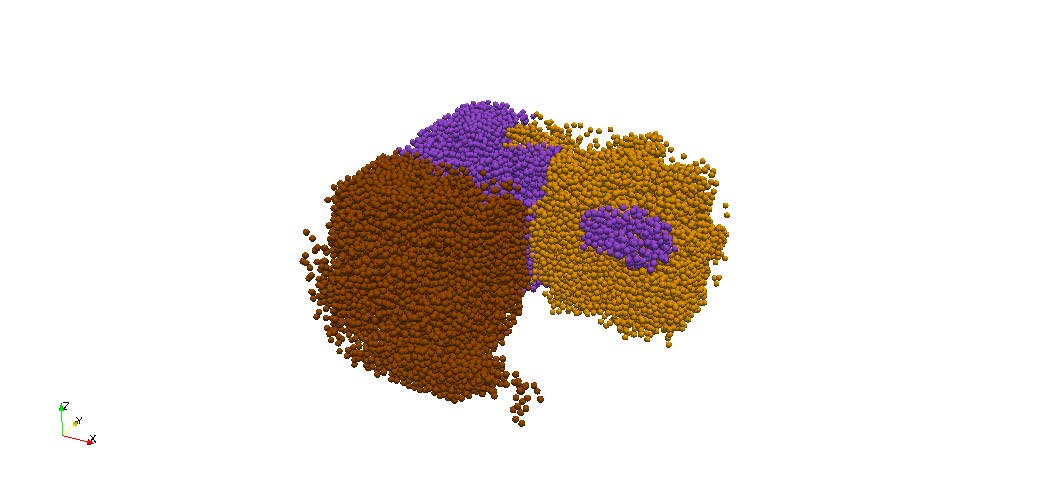Vehicle Controls & Behaviors
Annual PlanFast Numerical Algorithms for High-Fidelity Simulation of Terramechanics
Project Team
Government
Paramsothy Jayakumar, David Gorsich, U.S. Army GVSC
Industry
Tamer Wasfy, Advanced Science and Automation Corporation
Student
Eduardo Corona (post-doc), University of Michigan
Project Summary
Project began in an exploratory capacity Sept. 2016 and continues in the core portfolio since 2018.

High-fidelity simulations of soil mechanics and wheel-soil interactions is crucial to the success of integrated simulation environments for unmanned ground vehicles (UGVs) in off-road settings. Direct numerical simulations have received significant attention in the recent past as they mitigate the need for extensive experimentation, or offer predictive capabilities when experiments cannot be performed. However, physics-based high-fidelity simulations are extremely challenging owing to the multi-scale, multi-physics nature of these problems. Innovations in algorithms and the rapid progress in hardware are now enabling faster solves and several research groups have demonstrated grain-to-vehicle level simulations. Further innovations in software, however, are critical for simulations to play a bigger role in the design and performance assessment of UGVs.
Terrain typically is modeled as a granular media i.e., as a collection of particles of arbitrary shape; each responding to body forces such as gravity, inertia or drag, as well as repulsive or dissipative forces caused by contact. The discrete element method (DEM), also known as Nonsmooth Rigid Multibody Dynamics (NRMD), is one of the most widely used approaches to simulate the dynamics of granular materials. Distinct instances of the DEM are defined essentially by their modeling of contact forces, and thus in how collisions are handled.
Our aim is the development of numerical solvers to increase the efficiency and robustness of select approaches and methods, focusing on the acceleration of rapidly convergent second order methods. For this purpose, we have adapted hierarchical factorization techniques which produce robust, easy to update direct solvers for Primal-Dual Interior Point (PDIP) methods. We seek to further improve our method, integrate it with existing open-source software (Project CHRONO) and to design efficient and scalable parallel implementations. Ultimately, our goal is to apply these methods to the solution of large-scale terramechanics problems, where we believe they will have a transformative impact.
Publications from Prior Work:
- A. Rahimian, I. Lashuk, S. Veerapaneni, A. Chandramowlishwaran, D. Malhotra, L. Moon, R.Sampath, A. Shringarpure, J. Vetterz, R. Vuduc, D. Zorin, and G. Biros. Petascale direct numerical simulation of blood flow on 200K cores and heterogeneous architectures. ACM/IEEE Conference on Supercomputing, 2010.
- A. Barnett, B.Wu, and S. Veerapaneni. Spectrally-accurate quadratures for evaluation of layer potentials close to the boundary for the 2D Stokes and Laplace equations. SIAM Journal on Scientific Computing, Volume 37, Issue 4, 2015.
- Z. Gimbutas and S. Veerapaneni. A fast algorithm for spherical grid rotations and its application to singular quadrature. SIAM Journal on Scientific Computing, Volume 35 (6), 2013.
- S. Veerapaneni, A. Rahimian, G. Biros and D. Zorin. A fast algorithm for simulating vesicle flows in three dimensions. Journal of Computational Physics, Volume 230, Issue 14, 2011.
- R. Sampath, H. Sundar and S. Veerapaneni. Parallel fast Gauss transform. Proceedings of the 2010 ACM/IEEE International Conference for High Performance Computing, Networking, Storage and Analysis.
- M. Spivak, S. Veerapaneni and L. Greengard. The fast generalized Gauss transform. SIAM Journal on Scientific Computing, Volume 32, Issue 5, pages 3092-3107, October 2010.

